1. Analyzing Human Factors and Crew Resource Management
Human factors and crew resource management (CRM) play a crucial role in aviation safety. Understanding and analyzing these factors is essential for identifying areas for improvement in pilot training and overall aviation operations. Human factors encompass a wide range of elements that can influence performance, decision-making, and communication within the cockpit. These factors can include individual characteristics, such as experience, fatigue, and stress, as well as organizational and environmental factors. CRM, on the other hand, focuses on the effective utilization of all available resources, including human, technical, and informational, to enhance safety and operational efficiency.
1. Importance of Human Factors in Aviation:
Human factors directly impact the performance and decision-making abilities of pilots. For instance, fatigue can impair cognitive functioning and reaction times, increasing the risk of errors during critical flight phases. To mitigate this risk, airlines and regulatory bodies have implemented regulations that limit duty hours and mandate rest periods for pilots. Additionally, stress can affect situational awareness and attention, potentially leading to poor decision-making. By analyzing human factors, aviation stakeholders can identify areas where improvements can be made, such as implementing fatigue risk management systems and providing stress management training for pilots.
2. The Role of CRM in Aviation Safety:
Crew resource management is a concept that recognizes the importance of effective teamwork, communication, and decision-making within the cockpit. It emphasizes the need for open and assertive communication, shared situational awareness, and effective task allocation among the crew members. CRM training equips pilots with the skills to effectively manage resources, resolve conflicts, and make sound decisions in high-pressure situations. For example, during an emergency, CRM techniques enable pilots to coordinate their actions and effectively manage the situation, minimizing the risk of accidents.
3. Implementing CRM Training Programs:
Airlines and training organizations have incorporated CRM training programs into pilot training curricula to enhance safety and operational efficiency. These programs often include interactive workshops, simulator exercises, and case studies that simulate real-life scenarios. They focus on enhancing communication skills, leadership qualities, and teamwork among pilots. By analyzing CRM training outcomes and identifying areas for improvement, training providers can continually enhance their programs to address specific challenges faced by pilots.
4. Case Study: United Airlines Flight 232:
The crash of United Airlines Flight 232 in 1989 serves as a tragic example of the importance of CRM. Despite the catastrophic failure of the aircraft's hydraulic systems, the crew successfully managed to land the plane, saving the lives of many passengers. The effective coordination, communication, and utilization of available resources were critical in this incident. This case study highlights the significance of CRM training in preparing pilots to handle unforeseen events and emphasizes the need for continuous analysis and improvement of CRM practices.
5. Future Trends in Human Factors and CRM:
As aviation technology continues to advance, new human factors and CRM challenges emerge. For instance, the introduction of advanced automation systems may lead to complacency or overreliance on technology, reducing pilots' situational awareness. Additionally, the increasing diversity in the cockpit, with pilots from various cultural backgrounds, requires enhanced CRM practices to ensure effective communication and teamwork. By staying abreast of emerging trends and analyzing their impact on human factors and CRM, aviation stakeholders can proactively identify areas for improvement and adapt training programs accordingly.
Analyzing human factors and CRM is an ongoing process aimed at improving aviation safety. By understanding the importance of these factors, implementing effective CRM training programs, and continually analyzing outcomes and trends, the aviation industry can enhance pilot training and identify areas for improvement, ultimately ensuring safer skies for all.
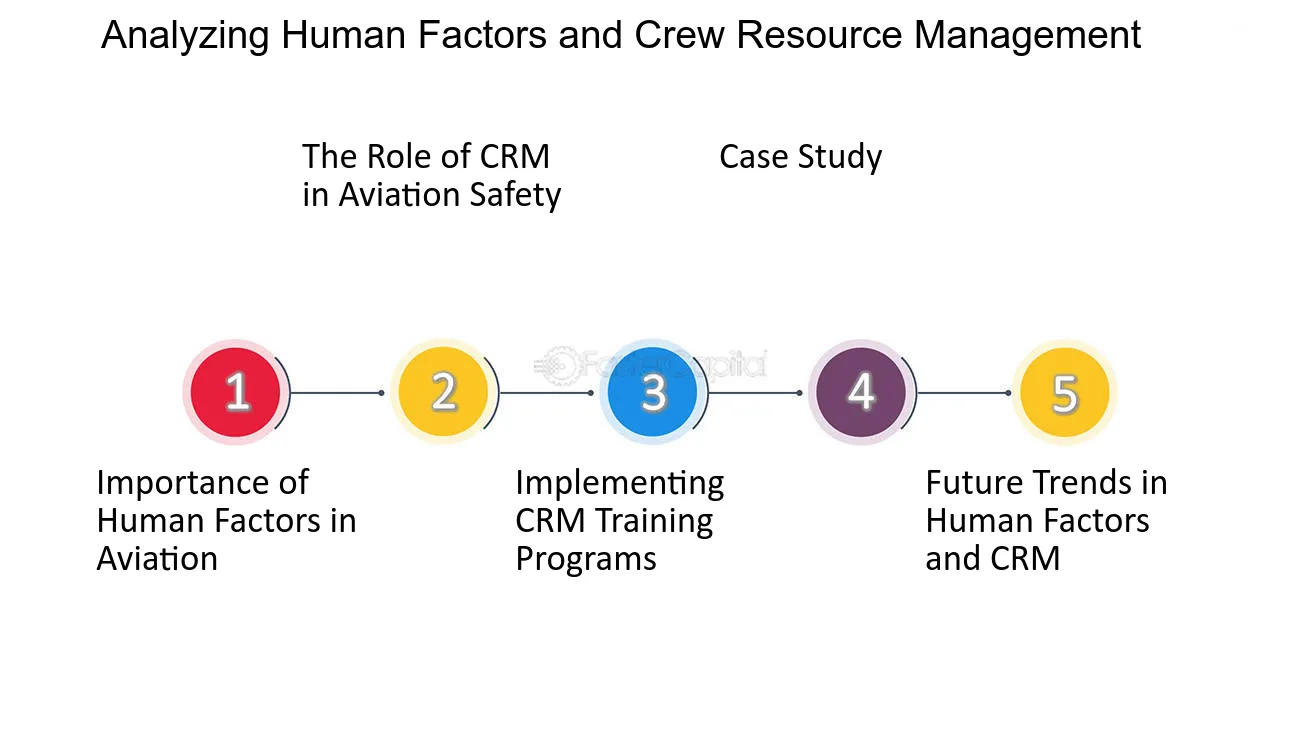
Analyzing Human Factors and Crew Resource Management - AAR and Pilot Training: Identifying Areas for Improvement
2. The Role of Human Factors in Aviation Accidents
When it comes to investigating aviation accidents, one cannot overlook the crucial role that human factors play in these incidents. Human factors refer to the interaction between humans and their environment, equipment, and procedures. In the context of aviation accidents, human factors encompass a wide range of elements, including pilot error, crew coordination, decision-making, training, and fatigue management. Understanding and addressing these human factors is essential in unraveling the puzzle of aviation accident investigations.
1. Pilot Error: One of the most common human factors contributing to aviation accidents is pilot error. This can occur due to a lack of situational awareness, poor decision-making, or inadequate training. For example, in the case of the Air France Flight 447 crash in 2009, pilot error played a significant role. The crew failed to react appropriately to a loss of airspeed indications, leading to a series of errors that ultimately resulted in the tragedy. Investigating pilot error involves analyzing the actions, decisions, and thought processes of the crew during critical moments.
2. Crew Coordination: Effective communication and coordination among the flight crew are essential for safe flight operations. However, breakdowns in crew coordination can lead to misunderstandings, errors, and ultimately, accidents. For instance, the crash of Eastern Air Lines Flight 401 in 1972 was partly attributed to a lack of crew coordination. The crew was preoccupied with troubleshooting a landing gear indicator light, causing them to lose situational awareness and subsequently crash into the Florida Everglades. Investigating crew coordination involves examining communication protocols, teamwork dynamics, and crew resource management.
3. Decision-Making: The ability to make sound decisions under challenging circumstances is critical for aviation safety. However, decision-making can be influenced by various factors, such as time pressure, cognitive biases, and incomplete or inaccurate information. For example, in the case of the Tenerife airport disaster in 1977, decision-making played a significant role. Miscommunication and poor decision-making by both air traffic control and the pilots resulted in a collision between two aircraft on the runway, leading to the deadliest aviation accident in history. Investigating decision-making involves analyzing the factors that influenced the choices made by individuals involved in the accident.
4. Training: Adequate training is paramount in ensuring that aviation professionals possess the necessary knowledge and skills to perform their duties safely. However, deficiencies in training programs can contribute to human errors and accidents. For instance, the crash of Asiana Airlines Flight 214 in 2013 was partly attributed to inadequate training on the use of the aircraft's automated systems. The pilots' lack of understanding and proficiency in managing these systems resulted in the aircraft stalling and crashing during landing. Investigating training involves evaluating the effectiveness of training programs, simulator exercises, and recurrent training requirements.
5. Fatigue Management: Fatigue can impair human performance, leading to reduced alertness, slower reaction times, and impaired decision-making abilities. Fatigue-related accidents can occur due to long duty hours, inadequate rest periods, and circadian rhythm disruptions. For example, the crash of Colgan Air Flight 3407 in 2009 was partly attributed to fatigue. The crew had been commuting overnight before their duty and did not have adequate rest, which likely contributed to their performance deficiencies. Investigating fatigue management involves assessing crew scheduling practices, duty time limitations, and rest requirements.
Understanding the role of human factors in aviation accidents is crucial for improving aviation safety. By examining elements such as pilot error, crew coordination, decision-making, training, and fatigue management, investigators can unravel the complex puzzle of aviation accident investigations. By identifying and addressing these human factors, the aviation industry can work towards preventing similar accidents in the future and ensuring the safety of both passengers and crew.
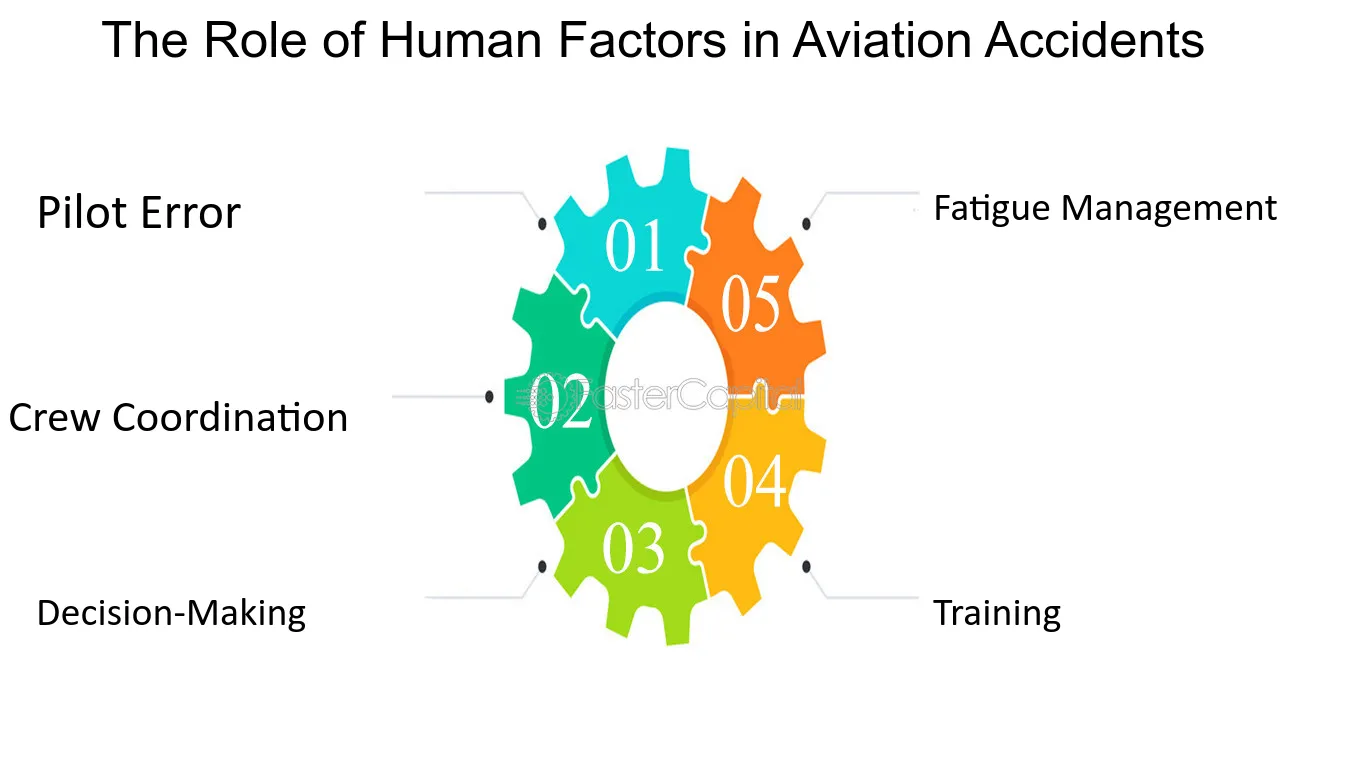
The Role of Human Factors in Aviation Accidents - Aviation Accident Investigation: Unraveling the AAR Puzzle
3. Identifying Human Factors through CVR Analysis
Human factors play a crucial role in aviation safety and are often identified through Cockpit Voice Recorder (CVR) analysis. The CVR captures the audio from the cockpit, including conversations between the flight crew, as well as ambient sounds and alarms. By analyzing these recordings, investigators can gain valuable insights into the human factors that may have contributed to an incident or accident. This section will delve into the various human factors that can be identified through CVR analysis, providing a deeper understanding of their impact on aviation safety.
1. Communication breakdown: CVR analysis can reveal instances of miscommunication or breakdowns in communication between the flight crew members. These can include unclear instructions, misunderstandings, or failures to acknowledge critical information. For example, in the case of the Tenerife airport disaster in 1977, CVR analysis revealed a miscommunication between the pilot and air traffic control, leading to a tragic collision.
2. Decision-making processes: The CVR provides insight into the decision-making processes of the flight crew. It can reveal whether decisions were made based on standard operating procedures, risk assessments, or other factors. By analyzing these processes, investigators can identify errors or biases that may have influenced the crew's decision-making. For instance, in the case of Air France Flight 447, CVR analysis showed that the crew made incorrect decisions based on their interpretation of the flight instruments, leading to the aircraft's tragic crash.
3. Crew coordination and teamwork: CVR analysis can shed light on the level of coordination and teamwork among the flight crew. It can reveal how effectively the crew members worked together, whether there were any conflicts or power differentials, and whether there were any breakdowns in crew resource management. An example of this is the crash of Eastern Air Lines Flight 401, where CVR analysis highlighted the lack of communication and coordination among the crew, resulting in the crew's failure to notice the aircraft's descent.
4. Fatigue and stress: The CVR can provide insights into the mental and physical states of the flight crew. It can reveal signs of fatigue, stress, or distractions that may have affected their performance. For instance, CVR analysis of the Colgan Air Flight 3407 crash indicated that the pilots were fatigued and engaged in non-essential conversation, contributing to the crew's failure to respond appropriately to the stall warning.
5. Training and proficiency: CVR analysis can also help assess the level of training and proficiency of the flight crew. It can reveal whether the crew members followed standard procedures, used appropriate terminology, or demonstrated knowledge of the aircraft systems. By identifying any gaps in training or proficiency, improvements can be made to enhance aviation safety. One notable example is the crash of Asiana Airlines Flight 214, where CVR analysis revealed the pilots' lack of understanding of the aircraft's automation, leading to a fatal misjudgment during the approach and landing.
CVR analysis is a valuable tool in identifying human factors that contribute to aviation incidents and accidents. By examining communication breakdowns, decision-making processes, crew coordination, fatigue and stress levels, and training proficiency, aviation authorities can implement measures to mitigate these factors and enhance aviation safety. Ultimately, the insights gained from CVR analysis can contribute to the continuous improvement of aviation practices and procedures, ensuring safer skies for all.
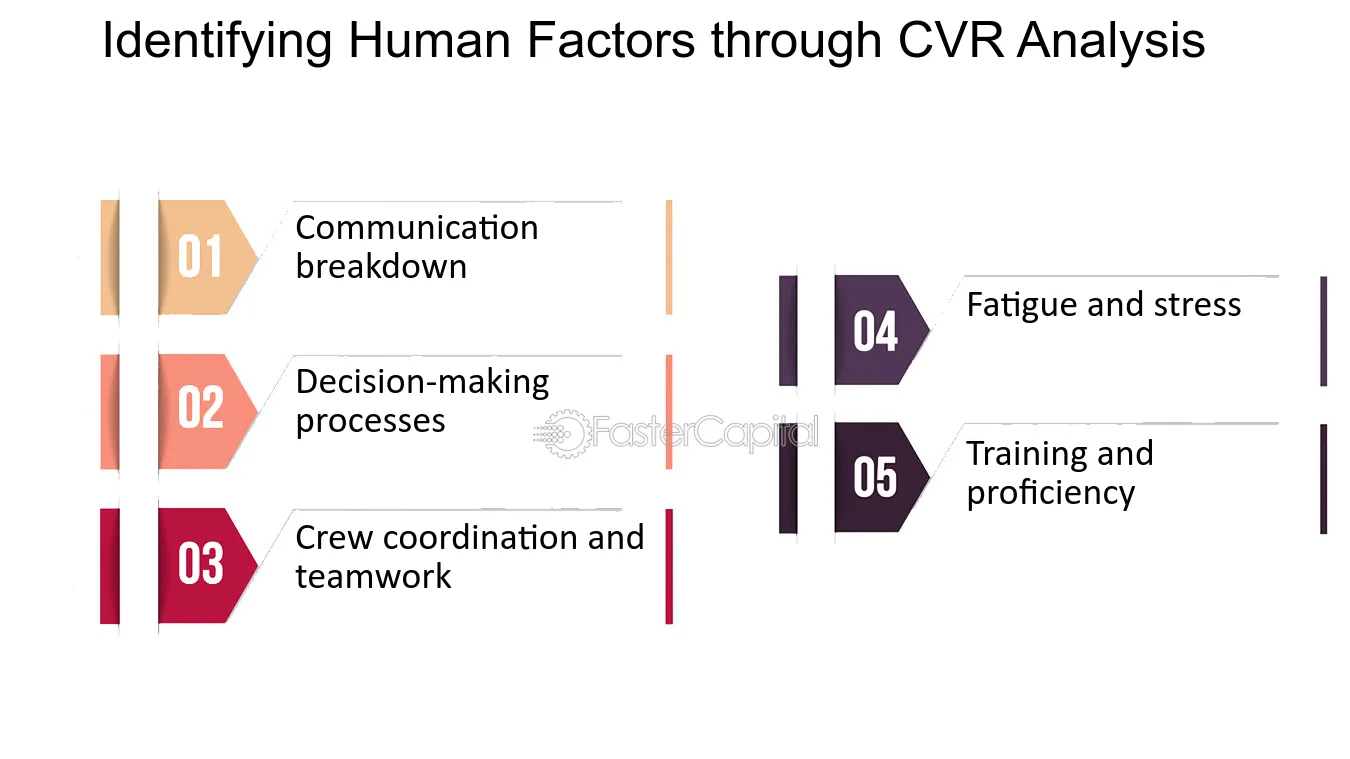
Identifying Human Factors through CVR Analysis - Aviation Safety: Enhancing Aviation Safety Through CVR Analysis
4. Human Factors Contributing to Dry Holes
Human Factors Contributing to Dry Holes
The exploration and drilling of oil and gas wells is a complex and risky business. Despite the best efforts of the industry, there are still instances where wells fail to produce the expected results. These dry holes can be costly and damaging to the reputation of the company involved. One of the main causes of dry holes is human error. In this section, we will explore the different human factors that can contribute to dry holes and how they can be avoided.
1. Lack of Experience and Knowledge
One of the most common human factors contributing to dry holes is the lack of experience and knowledge of the drilling team. Drilling a well requires a high level of technical expertise and understanding of the geology of the area. Without this knowledge, the team may make incorrect assumptions about the rock formations and miss potential oil and gas reservoirs.
To avoid this, companies should invest in training and development programs for their drilling teams. This will ensure that they have the necessary skills and knowledge to make informed decisions during the drilling process.
2. Poor Communication
Effective communication is crucial in any drilling operation. The failure to communicate effectively can result in mistakes, delays, and ultimately, dry holes. Poor communication can occur between different teams working on the same project or between the drilling team and the geologists.
To address this, companies should establish clear lines of communication and ensure that everyone involved in the project is aware of their roles and responsibilities. Regular meetings and briefings should also be held to ensure that everyone is on the same page.
3. Inadequate Planning
Inadequate planning is another human factor that can contribute to dry holes. This can include a lack of preparation for unexpected events such as equipment failure or adverse weather conditions. Without proper planning, the drilling team may not have the necessary resources or equipment to deal with these situations effectively.
To avoid this, companies should conduct thorough risk assessments and develop contingency plans for potential problems. This will ensure that the team is prepared for any eventuality and can respond quickly and effectively.
4. Rushing the Drilling Process
In some cases, the pressure to complete the drilling process quickly can lead to mistakes and ultimately, dry holes. Rushing the process can result in a lack of attention to detail and a failure to properly evaluate the geology of the area.
To avoid this, companies should prioritize safety and quality over speed. The drilling team should be given the time they need to properly evaluate the area and make informed decisions.
Human factors can contribute to dry holes in many ways. These can include a lack of experience and knowledge, poor communication, inadequate planning, and rushing the drilling process. By addressing these factors and investing in training and development programs, companies can reduce the risk of dry holes and improve the overall success of their drilling operations.
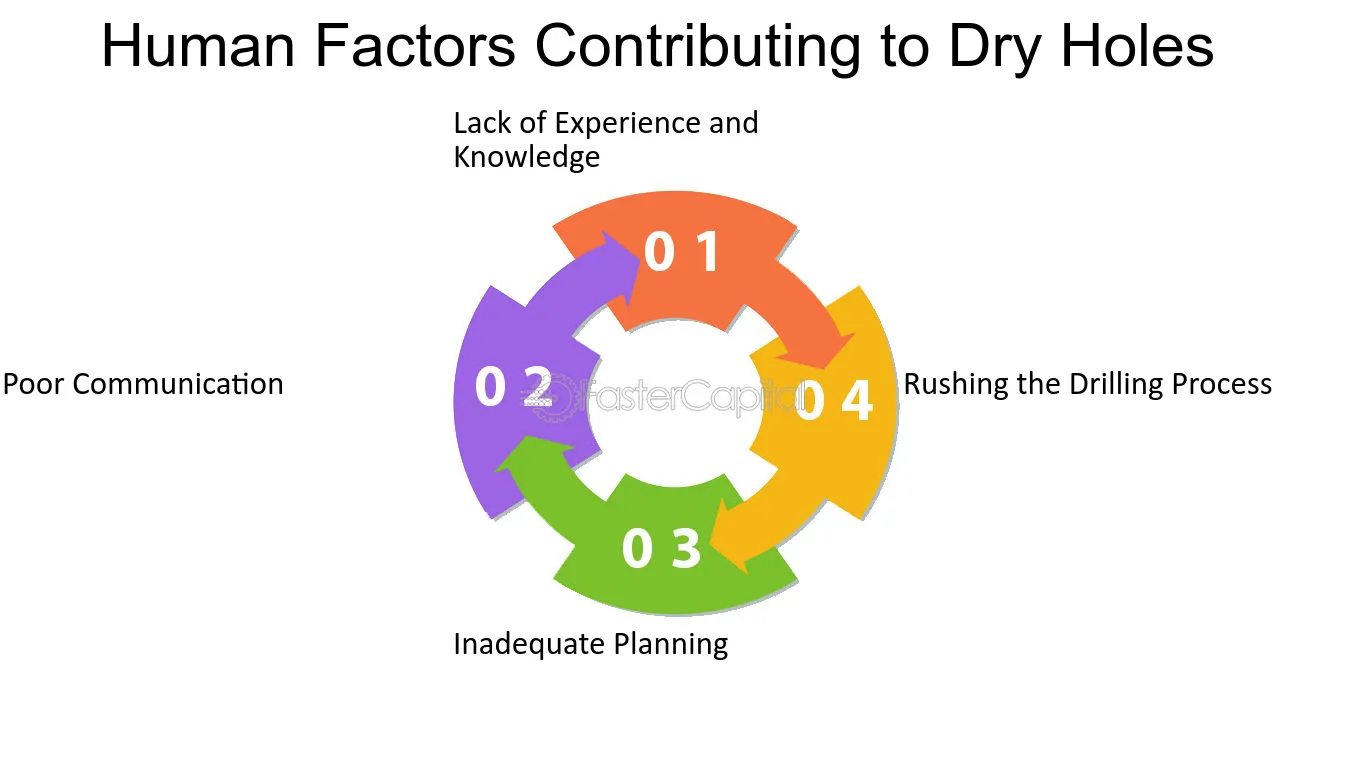
Human Factors Contributing to Dry Holes - Beneath the Cap: Unraveling the Mystery of Dry Holes
5. The Role of Human Factors in Error Propagation
Human factors play a crucial role in error propagation within complex systems. These factors refer to the ways in which human beings interact with technology, equipment, and other people in their environment. They include cognitive, social, and physical factors that can influence the likelihood of error, as well as the extent to which errors are propagated throughout a system. Understanding these factors is essential for identifying and mitigating potential sources of error in complex systems.
1. Cognitive Factors: One of the most significant human factors that contribute to error propagation is cognitive load. When individuals are required to process large amounts of information or make complex decisions quickly, they may be more susceptible to making errors. This can be exacerbated by factors such as stress, fatigue, and distractions. To reduce the risk of cognitive overload, systems should be designed with simplicity and clarity in mind. Additionally, training and support should be provided to help individuals manage their cognitive load effectively.
2. Social Factors: Social factors can also influence error propagation. For example, communication breakdowns between team members can lead to misunderstandings, resulting in errors. Similarly, conflicts between team members or a lack of trust can create a hostile environment that can impede effective collaboration and increase the likelihood of errors. To address these issues, it is essential to establish clear communication channels, build trust among team members, and foster a culture of collaboration and mutual support.
3. Physical Factors: Physical factors such as equipment design and ergonomics can also contribute to error propagation. Poorly designed equipment or workstations can lead to physical discomfort or injury, which can impair an individual's ability to perform their job effectively. Additionally, equipment that is difficult to use or maintain can increase the likelihood of errors. To mitigate these risks, systems should be designed with user-centered principles in mind. This involves considering the needs and capabilities of the individuals who will be using the equipment and ensuring that it is easy to use and maintain.
4. Training and Support: Effective training and support are critical in reducing the risk of error propagation. Individuals should be provided with the knowledge and skills they need to perform their jobs effectively, as well as ongoing support to help them manage the challenges they may encounter. This includes access to resources such as job aids, checklists, and feedback mechanisms that can help individuals identify and correct errors before they propagate throughout the system.
5. Monitoring and Feedback: Finally, monitoring and feedback mechanisms are essential for identifying and addressing errors as they occur. These mechanisms should be designed to provide real-time feedback to individuals and teams, allowing them to identify and correct errors as quickly as possible. Additionally, they should be used to track trends and patterns in error propagation, enabling organizations to identify systemic issues that may require more comprehensive solutions.
Human factors play a crucial role in error propagation within complex systems. By understanding these factors and implementing strategies to address them, organizations can reduce the risk of errors and minimize their impact when they do occur. Effective training and support, clear communication channels, user-centered design, and real-time monitoring and feedback are all critical components of a comprehensive approach to error prevention and mitigation.
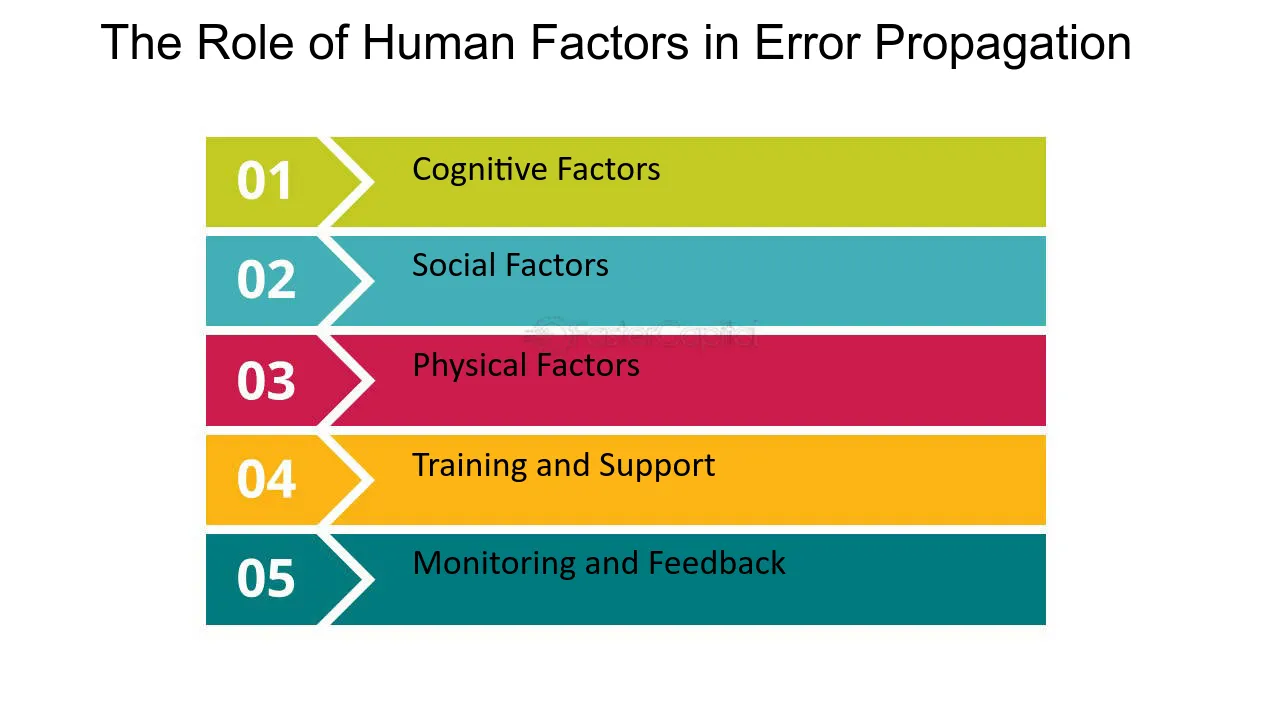
The Role of Human Factors in Error Propagation - Error propagation: Tracing the Ripple Effects of Errors in Complex Systems
6. Natural and Human Factors
1. Natural Factors:
Heatwaves are often the result of a combination of natural and human factors. When it comes to natural causes, one of the primary contributors to heatwaves is high-pressure systems. These systems create a dome of hot air that traps heat near the surface, preventing it from escaping into the atmosphere. As a result, the temperature rises significantly, leading to prolonged periods of extreme heat.
2. El Niño and La Niña:
The El Niño and La Niña phenomena also play a significant role in the occurrence of heatwaves. El Niño, characterized by the warming of the Pacific Ocean, can lead to changes in atmospheric circulation patterns, causing heatwaves in various regions around the world. Conversely, La Niña, which is associated with cooler-than-normal sea surface temperatures in the Pacific, can have the opposite effect, reducing the likelihood of heatwaves in certain areas.
3. Drought and Dry Conditions:
Drought and dry conditions are frequently linked to the occurrence of heatwaves. When an area experiences prolonged periods of little to no rainfall, the lack of moisture in the soil and vegetation amplifies the heating process. Without the cooling effect of evaporation, the land heats up rapidly, contributing to the intensity and duration of heatwaves. This was evident during the European heatwave of 2003, where a combination of drought and dry conditions led to thousands of deaths.
4. Human Factors:
While natural factors can contribute to heatwaves, human activities also play a significant role in their occurrence and severity. The phenomenon of urban heat islands is a prime example. Urban areas, with their vast concrete and asphalt surfaces, absorb and retain more heat than surrounding rural areas. As a result, cities experience higher temperatures, exacerbating the effects of heatwaves. The concentration of human activities, such as industrial processes and transportation, also contributes to the release of greenhouse gases, leading to global warming and an increased likelihood of heatwaves.
5. Climate Change:
Climate change, caused primarily by human activities, is a crucial factor in the rising frequency and intensity of heatwaves. The increase in greenhouse gas emissions, particularly carbon dioxide, traps more heat in the atmosphere, leading to a global temperature rise. This, in turn, creates favorable conditions for the occurrence of heatwaves. Numerous studies have shown a direct link between climate change and the increased frequency of extreme heat events worldwide.
6. Case Study: Australia's Black Saturday:
The devastating heatwave that struck Australia in 2009, known as Black Saturday, serves as a stark example of the combined influence of natural and human factors. A prolonged period of intense heat, exacerbated by strong winds and dry conditions, led to catastrophic bushfires that claimed the lives of 173 people and caused extensive damage. This event highlighted the need for effective heatwave preparedness and the importance of understanding the complex interplay between natural and human factors in heatwave formation.
7. Tips for Heatwave Preparedness:
In light of the causes of heatwaves, it is essential to be prepared and take necessary precautions during extreme heat events. Stay hydrated by drinking plenty of water, avoid outdoor activities during the hottest parts of the day, and seek air-conditioned or shaded areas when possible. Additionally, check on vulnerable individuals, such as the elderly or those with pre-existing health conditions, and ensure they have access to cool environments. By being proactive and informed, we can mitigate the risks associated with heatwaves and protect ourselves and our communities.
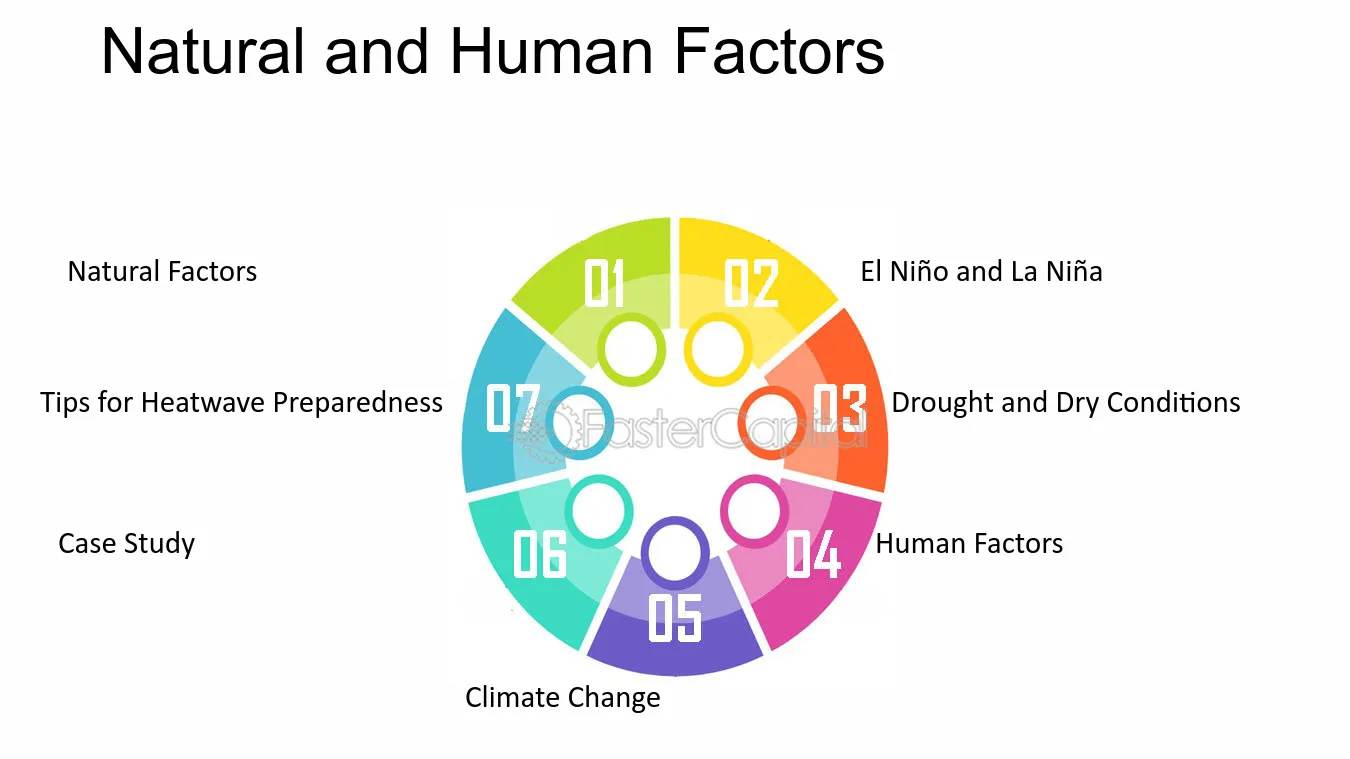
Natural and Human Factors - Heatwaves: Scorching Summers: The Phenomenon of Heatwaves
7. The Role of Human Factors in Design and Ergonomics
Human factors are an essential element in the design of products and systems for human use. Human factors refer to the psychological, social, and physical characteristics of humans that influence their interactions with products, systems, and environments. The role of human factors in design and ergonomics is crucial in developing products that are user-friendly, efficient, and safe. Human factors engineering involves designing products, systems, and environments that are safe, efficient, and effective for human use. It is an interdisciplinary field that draws on various disciplines such as psychology, engineering, and ergonomics to ensure that products are designed with the user in mind.
Here are some points that highlight the role of human factors in design and ergonomics:
1. human-Centered design: Human factors play a critical role in human-centered design, a design approach that focuses on the needs, wants, and limitations of end-users. By understanding the needs and limitations of users, designers can create products that are more effective, efficient, and satisfying to use. For example, a smartphone's user interface is designed with human factors in mind, such as the size of the buttons and the placement of the functions, to make it easier and more intuitive to use.
2. Usability: Human factors are essential in ensuring product usability. Usability refers to the ease of use and learnability of a product. Designers use human factors principles to create products that are easy to learn and use. For example, a car's dashboard is designed with human factors in mind, such as the placement of the speedometer and the visibility of the warning lights, to make it easy for the driver to monitor the car's performance.
3. Safety: Human factors play a crucial role in ensuring product safety. Designers use human factors principles to identify potential hazards and to develop products that are safe for use. For example, the design of a medical device is crucial to ensure that it is safe and effective in its use. The design should take into account the user's physical abilities, visual acuity, and cognitive abilities to minimize the risk of injury or harm.
4. Ergonomics: Human factors engineering is also known as ergonomics, which is the science of designing products, systems, and environments to fit the needs and capabilities of the user. Ergonomics principles are used to design products that minimize physical effort, reduce fatigue, and prevent injury. For example, ergonomic keyboards are designed to reduce the risk of repetitive strain injuries by reducing the strain on the user's wrists and hands.
The role of human factors in design and ergonomics is crucial in developing products that are user-friendly, efficient, and safe. By understanding the needs, wants, and limitations of end-users, designers can create products that are more effective, efficient, and satisfying to use. Human factors engineering is an interdisciplinary field that draws on various disciplines such as psychology, engineering, and ergonomics to ensure that products are designed with the user in mind.
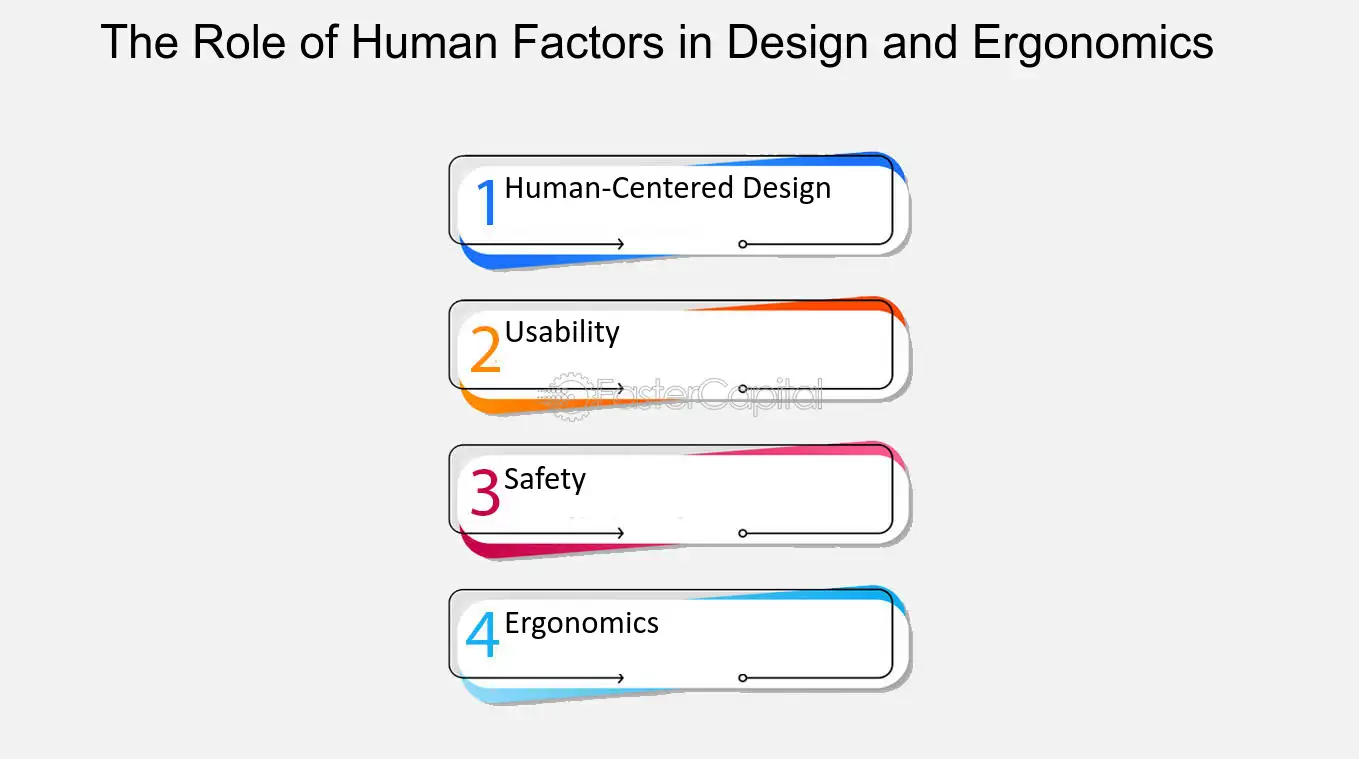
The Role of Human Factors in Design and Ergonomics - Human Factors: Examining the Hawthorne Effect in Design and Ergonomics
8. The Significance of Human Factors in AAR
The significance of human factors in After Action Reviews (AARs) cannot be overstated. AARs are crucial tools used by organizations to evaluate performance, identify strengths and weaknesses, and improve future outcomes. While many factors contribute to the success or failure of an operation, it is often the human element that plays a pivotal role. Human factors encompass a wide range of aspects related to human performance, including cognitive abilities, decision-making processes, teamwork, communication, and individual behavior. Understanding and analyzing these factors within the context of AARs is essential for enhancing organizational learning and preventing future errors.
1. Human error as a root cause: One of the primary reasons why human factors are significant in AARs is because human error is often identified as a root cause of incidents or failures. It is crucial to recognize that human error is not synonymous with negligence or incompetence. In fact, errors can occur even when individuals have the best intentions and are highly skilled. By understanding the underlying human factors that contribute to errors, organizations can implement targeted interventions to mitigate their occurrence. For example, a transportation company conducting an AAR after a train derailment may identify fatigue as a human factor that contributed to the error. This insight could lead to implementing fatigue management strategies, such as revised work schedules or improved rest facilities, to prevent similar incidents in the future.
2. Enhancing situational awareness: Human factors play a significant role in enhancing situational awareness during complex operations. Situational awareness refers to an individual's perception and understanding of the current situation, including the ability to anticipate future events and make informed decisions accordingly. Effective communication, information processing, and decision-making skills are all critical components of situational awareness. By examining human factors in AARs, organizations can identify areas where situational awareness was compromised and develop strategies to improve it. For instance, an AAR conducted after a military operation may reveal that poor communication between team members led to a lack of situational awareness, resulting in a missed opportunity or an unintended consequence. This insight could prompt the implementation of communication protocols, training programs, or technological solutions to enhance situational awareness in future operations.
3. Team dynamics and collaboration: AARs provide an opportunity to evaluate team dynamics and collaboration within an organization. Human factors such as teamwork, leadership, and interpersonal skills significantly impact the effectiveness of teams. By analyzing these factors in AARs, organizations can identify strengths and weaknesses in team dynamics and take appropriate actions to improve collaboration. For example, an AAR conducted after a healthcare incident may reveal that ineffective communication and a lack of shared mental models among the medical team contributed to a delay in treatment. This insight could lead to training programs focused on enhancing communication skills, fostering a culture of collaboration, and promoting shared decision-making processes.
4. Learning from success: While AARs are often associated with identifying and learning from failures, they are equally valuable in understanding and replicating success. By examining human factors in successful operations, organizations can identify best practices and behaviors that contributed to positive outcomes. For instance, an AAR conducted after a successful emergency response may reveal that effective leadership, clear communication, and quick decision-making were critical factors in the operation's success. This insight can be used to develop training programs or guidelines that promote these behaviors in future operations, enhancing overall performance.
5. Continuous improvement and risk management: Human factors are integral to continuous improvement and risk management within organizations. AARs provide a platform for identifying and addressing human factors that increase the likelihood of errors or incidents. By incorporating human factors analysis into AARs, organizations can proactively identify potential risks and develop strategies to mitigate them. For example, an AAR conducted after a cybersecurity breach may reveal that a lack of employee awareness and training on cybersecurity best practices contributed to the incident. This insight could lead to the implementation of comprehensive training programs and awareness campaigns to reduce the organization's vulnerability to similar breaches in the future.
The significance of human factors in AARs cannot be overlooked. By understanding and analyzing human performance, decision-making processes, teamwork, communication, and individual behavior within the context of AARs, organizations can enhance their learning, prevent future errors, and improve overall performance. Human factors analysis in AARs provides valuable insights from different perspectives, enabling organizations to develop targeted interventions, enhance situational awareness, improve team dynamics, replicate success, and continuously improve risk management practices.
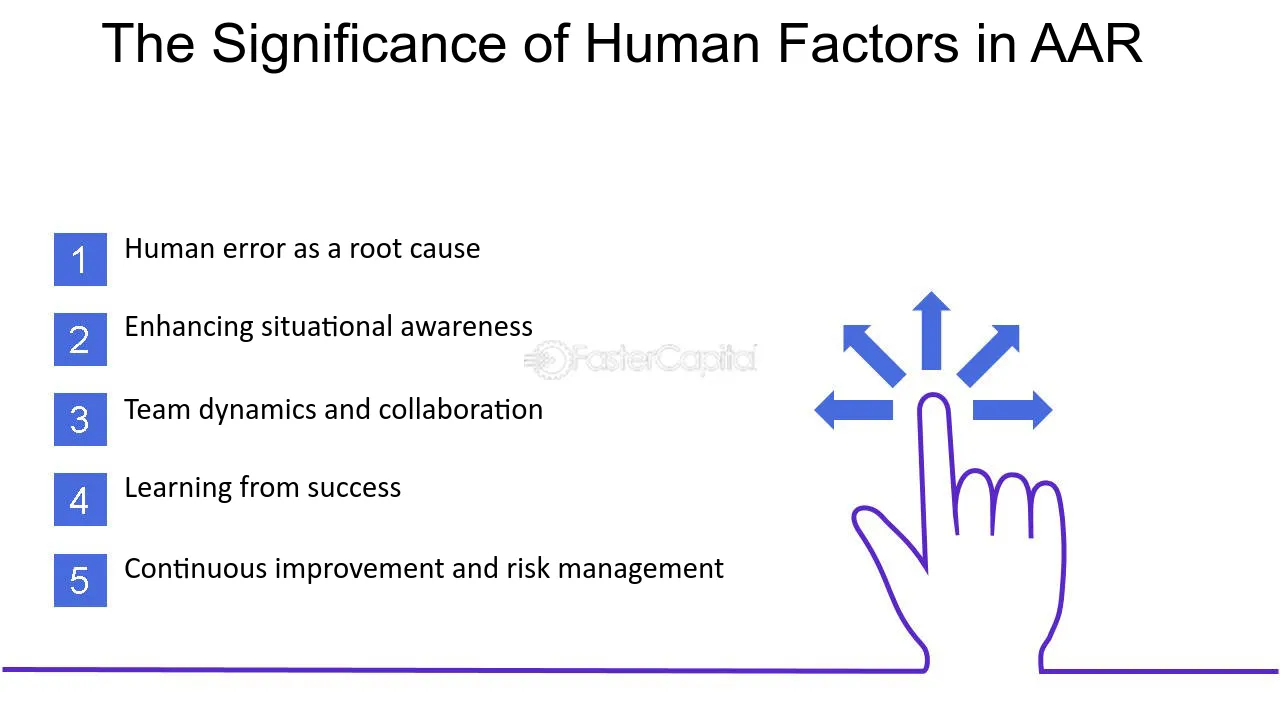
The Significance of Human Factors in AAR - Human Factors in AAR: Understanding the Role of Human Error
9. Human Factors in Aviation Accidents
When it comes to aviation accidents, it is essential to acknowledge the crucial role that human factors play in these unfortunate events. Human factors encompass a wide range of elements, including the interactions between individuals, machines, and their environments. In the aviation industry, understanding human factors is of utmost importance in order to prevent accidents and improve overall safety. In this section, we will delve into the various aspects of human factors in aviation accidents, exploring insights from different perspectives and providing in-depth information to shed light on this critical subject.
1. Pilot Error: One of the most common human factors contributing to aviation accidents is pilot error. Pilots are highly skilled professionals who undergo extensive training, yet they are still susceptible to making mistakes. Fatigue, stress, distraction, and poor decision-making can all lead to pilot error. For example, the crash of Air France Flight 447 in 2009 was primarily attributed to pilot error. The crew's misinterpretation of the aircraft's stall warnings and their failure to apply the appropriate recovery techniques resulted in the tragic accident.
2. Crew Resource Management (CRM): CRM is a concept that focuses on effective communication, teamwork, and decision-making within the cockpit. It aims to optimize the human element of aviation by emphasizing the importance of clear communication, assertiveness, and mutual respect among crew members. CRM training has significantly contributed to reducing aviation accidents caused by human error. For instance, after the crash of United Airlines Flight 173 in 1978, where poor CRM played a significant role, the aviation industry recognized the need for improved crew coordination and implemented CRM programs to enhance safety.
3. Automation Dependency: With the advancement of technology, aircraft have become increasingly automated. While automation has undoubtedly improved safety in many aspects, it has also introduced new challenges related to human factors. Pilots can become overly reliant on automation, leading to complacency and a decrease in manual flying skills. This dependency can be problematic when systems fail or when pilots need to take over control in critical situations. The crash of Asiana Airlines Flight 214 in 2013 serves as an example of automation dependency, where the pilots' lack of understanding of the aircraft's autothrottle system led to a fatal crash.
4. Organizational Factors: Human factors extend beyond the individuals directly involved in flying the aircraft. Organizational factors, such as management practices, training programs, and safety culture, can greatly influence the likelihood of aviation accidents. For instance, inadequate maintenance practices or pressure from management to meet schedules can compromise safety. The crash of ValuJet Flight 592 in 1996 was attributed to organizational factors, including improper handling and transportation of hazardous materials, ultimately leading to a catastrophic accident.
5. Human-Machine Interface: The design of cockpit instruments, controls, and displays significantly impacts the interaction between pilots and machines. A poor human-machine interface can increase the likelihood of errors and confusion. Conversely, a well-designed interface can enhance situational awareness and reduce the risk of accidents. An example of the importance of human-machine interface is the crash of Eastern Air Lines Flight 401 in 1972, where the cockpit crew became fixated on a faulty landing gear indicator, leading to the aircraft's descent into the Everglades.
Understanding the role of human factors in aviation accidents is crucial for improving safety in the industry. By addressing pilot error, enhancing crew resource management, managing automation dependency, considering organizational factors, and improving the human-machine interface, we can strive to minimize the occurrence of tragic accidents and ensure a safer future for aviation.
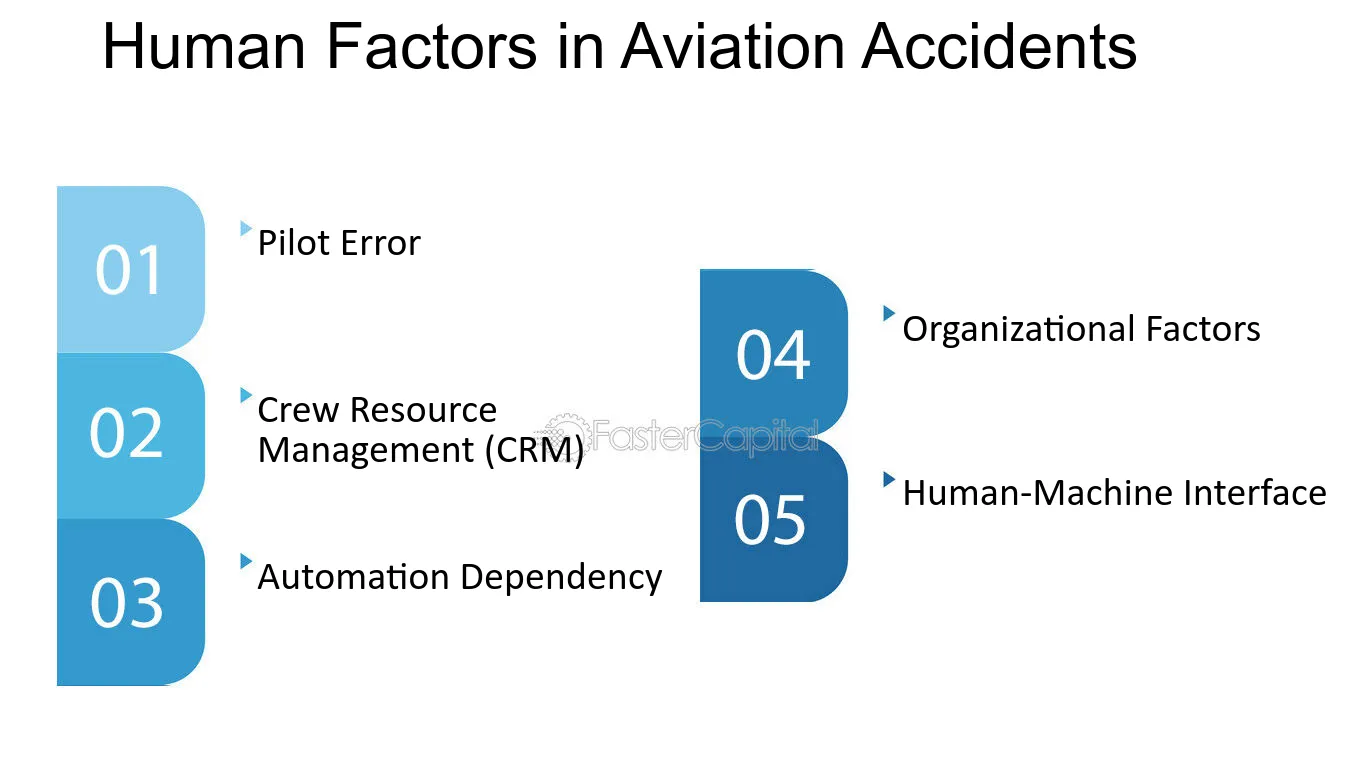
Human Factors in Aviation Accidents - Inside Aviation Accident Reports: The Crucial Role of AAR
10. Emotional Design:Adding Human Factors to Lean Startup
The goal of lean Startup is to create a successful business by quickly and cheaply testing new ideas. The Lean Startup approach is based on the premise that successful businesses are those that can rapidly move from concept to market. To do this, Lean Startup relies on data and feedback from customers and employees.
However, many businesses find it difficult to quickly and cheaply test their ideas. This is because they ignore the emotional factors that affect people's decisions. This is where human factors come in.
Human factors are the factors that involve people in an organization. They include things like communication, decision making, and teamwork.
The goal of adding human factors to Lean startup is twofold. First, it helps businesses understand how people make decisions. Second, it helps businesses improve their communication and decision making processes.
1) Understanding How People Make Decisions
One of the main goals of adding human factors to Lean Startup is to help businesses better understand how people make decisions. This is important because it allows businesses to better communicate their products and services.
For example, businesses can use human factors research to learn about how people process information. They can also use this information to improve their customer service strategies.
2) Improved Communication and Decision Making Processes
Another goal of adding human factors to Lean Startup is to improve communication and decision making processes. This is important because it allows businesses to better coordinate their operations.
For example, businesses can use human factors research to learn about how people interact with each other. They can also use this information to improve their teambuilding strategies.
11. Human Factors and Rollover Crash Risk
1. Importance of Human Factors in Rollover Crash Risk
When examining the dynamics of rollover crashes, it becomes evident that human factors play a significant role in determining the risk of such incidents. While vehicle design and road conditions are crucial factors, the actions and decisions made by drivers can greatly influence the likelihood of a rollover. Understanding these human factors is essential for developing effective strategies to mitigate rollover crash risk.
2. Driver Behavior and Its Impact on Rollover Risk
One of the primary human factors contributing to rollover crashes is driver behavior. Factors such as speeding, aggressive driving, distracted driving, and impaired driving significantly increase the chances of a rollover. For instance, a driver who exceeds the speed limit around a sharp curve may lose control of their vehicle, leading to a rollover. Similarly, a distracted driver who fails to react promptly to sudden changes in road conditions may also be at a higher risk. It is crucial to address these behavioral aspects to reduce rollover crash risk effectively.
3. Vehicle Occupancy and Rollover Crash Risk
Another critical human factor to consider is the occupancy of the vehicle. The number and position of occupants can impact the stability of the vehicle during a rollover event. For instance, an overloaded vehicle with excessive cargo or passengers may have a higher center of gravity, making it more prone to rolling over. Additionally, the distribution of weight within the vehicle can also affect its stability. Unevenly distributed weight, such as heavy cargo on one side, can increase the likelihood of a rollover. Ensuring proper loading and passenger distribution is crucial to minimize rollover crash risk.
4. Driver Experience and Training
The experience and training of drivers also play a role in rollover crash risk. Novice drivers, especially teenagers, are more likely to be involved in rollover crashes due to their limited driving skills and lack of experience in handling challenging road situations. Providing comprehensive driver training programs that focus on defensive driving techniques, hazard perception, and vehicle dynamics can significantly reduce the risk of rollovers. Furthermore, ongoing driver education and awareness campaigns can help reinforce safe driving practices and promote responsible behavior on the road.
5. Vehicle Safety Features and Rollover Crash Prevention
Vehicle manufacturers have made significant advancements in developing safety features that can help prevent rollover crashes. Electronic Stability Control (ESC) systems, for example, have proven to be effective in reducing the risk of rollovers by automatically applying brakes and adjusting engine torque to maintain vehicle stability during sudden maneuvers or loss of control. Additionally, rollover protection systems, such as reinforced roofs and seatbelt pretensioners, can provide enhanced occupant protection in the event of a rollover. It is crucial for drivers to consider these safety features when purchasing a vehicle, as they can significantly contribute to reducing rollover crash risk.
6. Collaboration and Education for Effective Risk Reduction
To effectively address the human factors associated with rollover crash risk, collaboration among various stakeholders is essential. Government agencies, vehicle manufacturers, traffic safety organizations, and driving schools should work together to develop comprehensive strategies that focus on driver education, vehicle safety improvements, and enforcement of traffic regulations. By combining efforts and sharing knowledge, it is possible to create a safer road environment and reduce the incidence of rollover crashes.
Understanding the human factors contributing to rollover crash risk is crucial for developing effective measures to prevent such incidents. By addressing driver behavior, vehicle occupancy, driver training, and vehicle safety features, it is possible to significantly reduce the likelihood of rollovers. The collaboration of various stakeholders and ongoing education efforts are key to achieving substantial progress in improving road safety and minimizing rollover crash risk.
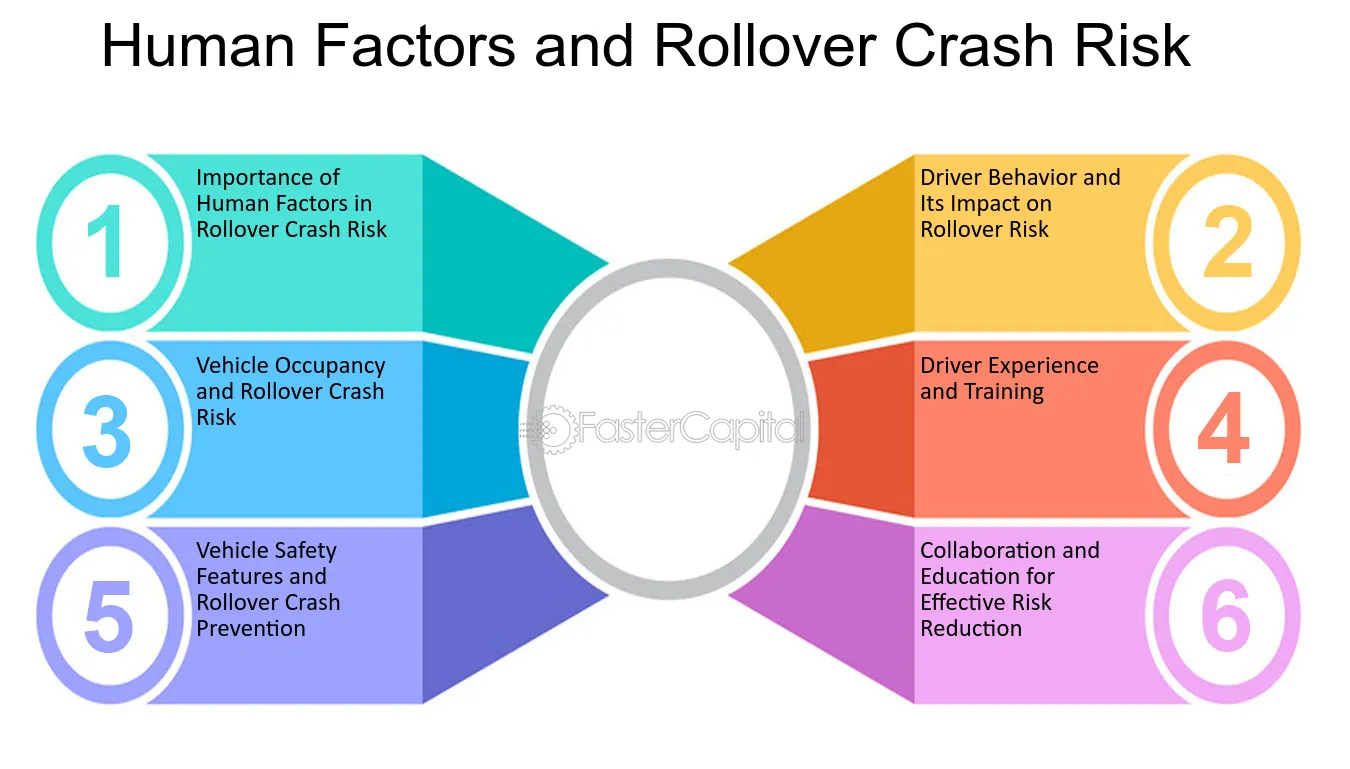
Human Factors and Rollover Crash Risk - Rollover crash dynamics: Physics behind the incidents
12. Investigating Driver Behavior and Human Factors
Investigating Driver Behavior and Human Factors
When it comes to unraveling the causes of rollover crashes, one crucial aspect that cannot be overlooked is the investigation of driver behavior and human factors. Understanding how drivers interact with their vehicles and the environment is paramount in determining the root causes of these accidents. By delving into this subject, we can shed light on the various factors that contribute to rollover crashes, thereby paving the way for effective prevention strategies.
1. The Role of Distraction:
One of the primary factors affecting driver behavior is distraction. With the increasing prevalence of smartphones and other electronic devices, drivers are often tempted to divert their attention away from the road. A study conducted by the National Highway Traffic Safety Administration (NHTSA) revealed that distracted driving accounted for approximately 10% of fatal crashes. To mitigate this risk, implementing stricter laws regarding cellphone usage while driving and promoting public awareness campaigns on the dangers of distraction are essential steps.
2. Impairment and Substance Abuse:
Impaired driving due to alcohol or drug use is another critical human factor contributing to rollover crashes. Studies have shown that intoxicated drivers are more prone to reckless behavior, reduced reaction times, and impaired judgment, all of which significantly increase the likelihood of rollovers. To combat this issue, stricter penalties for driving under the influence and increased law enforcement efforts to detect impaired drivers are necessary. Additionally, educational programs on the consequences of substance abuse should be widely implemented to promote responsible behavior.
3. Fatigue and Drowsiness:
Fatigue and drowsiness can have a severe impact on driver behavior. Sleep-deprived drivers are more likely to experience slower reaction times, impaired cognitive functioning, and even momentary lapses in attention, leading to rollover crashes. Employers should encourage adequate rest breaks for drivers, and public awareness campaigns should emphasize the importance of getting sufficient sleep before embarking on long journeys. Furthermore, technological advancements such as driver fatigue detection systems can provide an additional layer of safety by alerting drivers when their fatigue levels become dangerously high.
4. Speeding and Reckless Driving:
Excessive speed and reckless driving are significant contributors to rollover crashes. When drivers exceed the speed limit or engage in aggressive behaviors such as tailgating and improper lane changes, they significantly increase the chances of losing control of their vehicles. Implementing strict traffic enforcement measures, including speed cameras and increased police presence, can act as deterrents to speeding and reckless driving. Additionally, public education campaigns should stress the importance of adhering to speed limits and practicing defensive driving techniques.
5. Vehicle Design and Safety Features:
While driver behavior plays a crucial role in rollover crashes, vehicle design and safety features also deserve attention. Modern vehicles equipped with advanced safety features like electronic stability control (ESC), rollover protection systems, and seatbelt pre-tensioners can significantly reduce the risk of rollovers and mitigate the severity of injuries in the event of an accident. It is imperative for manufacturers to continue innovating and implementing such technologies to enhance overall vehicle safety.
Investigating driver behavior and human factors is an integral part of understanding the causes of rollover crashes. By addressing distractions, impairment, fatigue, reckless driving, and improving vehicle safety features, we can create a safer driving environment for everyone. Through a holistic approach that combines legislation, education, and technological advancements, we can work towards reducing the occurrence of rollover crashes and saving countless lives on the road.
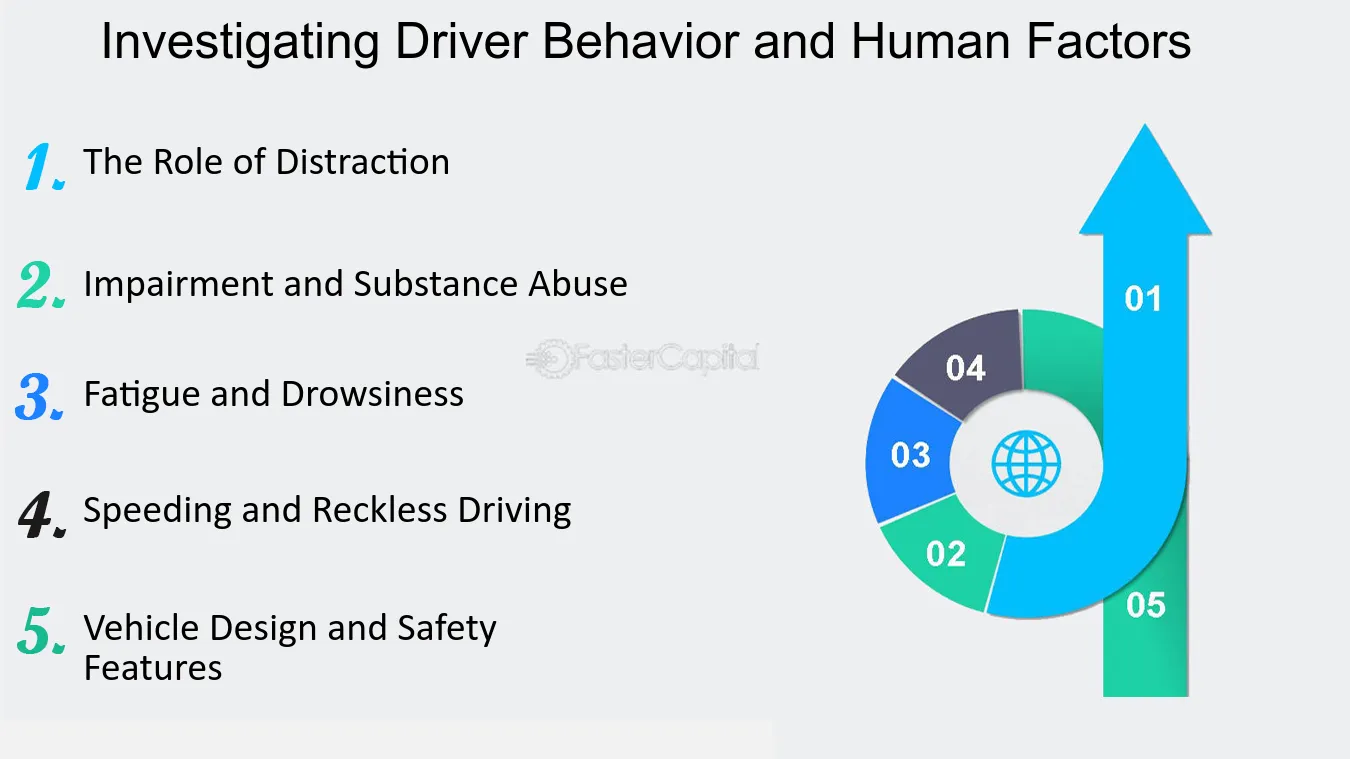
Investigating Driver Behavior and Human Factors - Rollover crash investigation: Unraveling the causes
13. Evaluating Driver Behavior and Human Factors
Evaluating Driver Behavior and Human Factors
When it comes to assessing the risk of rollovers and identifying potential hazards, it is crucial to consider not only the vehicle itself but also the driver's behavior and human factors. Driver behavior plays a significant role in determining the likelihood of a rollover, as certain actions or decisions can increase the chances of losing control of the vehicle. Human factors, on the other hand, encompass a wide range of elements such as perception, cognition, and physical abilities that can impact the driver's ability to safely operate the vehicle.
1. Perception and Attention:
One of the key human factors that affect driver behavior is perception and attention. Drivers need to accurately perceive their surroundings and pay attention to potential hazards on the road. However, distractions such as mobile phones, loud music, or even fatigue can impair a driver's ability to perceive and react to critical situations promptly. It is crucial for drivers to remain focused and attentive to minimize the risk of rollovers.
2. Decision Making:
Another essential aspect of evaluating driver behavior is assessing their decision-making skills. Drivers need to make quick and appropriate decisions while on the road to avoid dangerous situations. For instance, when encountering a sharp curve, the driver must decide whether to reduce speed, apply brakes, or maintain the current speed. Poor decision-making can significantly increase the risk of a rollover. Proper driver training and education can help enhance decision-making skills in critical situations.
3. Speed and Aggressiveness:
Speeding and aggressive driving are major contributors to rollover accidents. Excessive speed reduces the vehicle's stability and control, making it more susceptible to rollovers. Additionally, aggressive driving behaviors like tailgating, sudden lane changes, or aggressive maneuvers increase the likelihood of losing control of the vehicle. It is crucial for drivers to adhere to speed limits and practice defensive driving techniques to mitigate the risk of rollovers.
4. Vehicle Familiarity:
Familiarity with the vehicle is another factor that can impact driver behavior. Drivers who are less familiar with a particular vehicle may have a higher chance of making errors in judgment or handling. For example, a driver who is used to driving a smaller car may have difficulty adjusting to the handling characteristics of a larger SUV or truck. Proper training and practice with different vehicles can help drivers become more comfortable and confident, reducing the risk of rollovers.
5. Advanced Driver Assistance Systems (ADAS):
With advancements in technology, vehicles now come equipped with various Advanced Driver Assistance Systems (ADAS) that aim to improve safety on the road. These systems, such as lane departure warning, automatic emergency braking, or stability control, can assist drivers in avoiding rollovers and other accidents. However, it is important to note that ADAS systems should not replace responsible driving practices but rather complement them. Drivers should still remain vigilant and actively engaged while driving.
In evaluating driver behavior and human factors, it is evident that a combination of factors contributes to the risk of rollovers. From perception and attention to decision-making skills and vehicle familiarity, each element plays a crucial role. While advanced technologies can assist drivers in mitigating the risk, responsible driving practices and adherence to speed limits remain paramount. By considering and addressing these factors, we can enhance road safety and reduce the occurrence of rollover accidents.
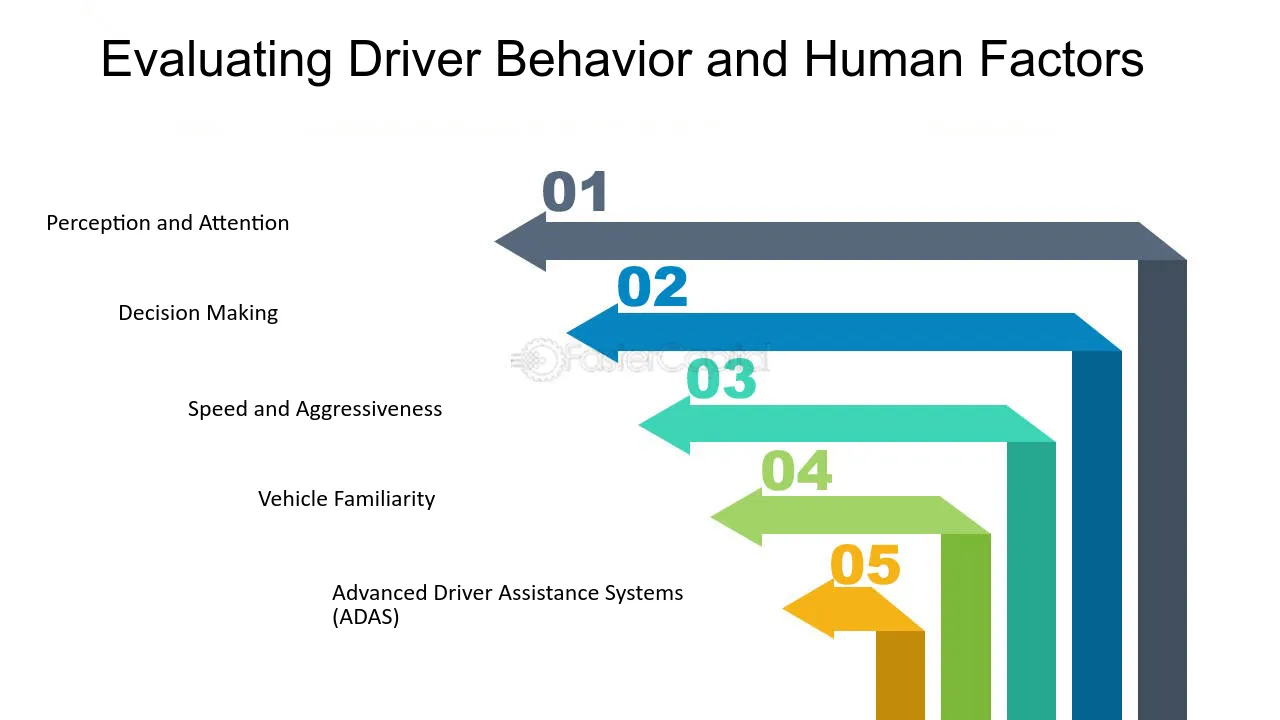
Evaluating Driver Behavior and Human Factors - Rollover risk assessment: Identifying potential hazards
14. Exploring Human Factors
1. Distracted Driving: A Leading Cause of Motor Vehicle Accidents
Distracted driving has become an epidemic on our roads, with devastating consequences. Whether it's texting, talking on the phone, eating, or even adjusting the radio, any activity that diverts attention from driving can significantly increase the risk of a crash. According to the National Highway Traffic Safety Administration (NHTSA), in 2019 alone, distracted driving claimed the lives of 3,142 people in the United States.
- Engaging in any form of distracted driving, such as texting, increases the likelihood of a crash by a staggering 23 times. Despite the well-known risks, many drivers continue to succumb to distractions. One potential solution to combat this issue is the implementation of stricter laws and penalties for distracted driving. By enforcing hefty fines and license suspensions, drivers may think twice before reaching for their phones while behind the wheel.
- Another option is the advancement of technology within vehicles. Many newer vehicles come equipped with hands-free calling, voice recognition systems, and even text-to-speech capabilities. By utilizing these features, drivers can stay connected while keeping their hands on the wheel and eyes on the road. However, it is important to note that even hands-free devices can still be distracting, as they require cognitive attention. Therefore, it is crucial for drivers to exercise self-discipline and prioritize their focus on driving.
2. Impaired Driving: A Deadly Decision
Impaired driving, whether due to alcohol, drugs, or even certain medications, remains a significant contributor to motor vehicle accidents. Despite widespread awareness campaigns and stricter penalties, impaired driving continues to claim lives and cause immeasurable pain and suffering for victims and their families.
- One effective solution to combat impaired driving is the implementation of sobriety checkpoints. These checkpoints, where law enforcement officers stop vehicles to check for signs of impairment, have proven to be an effective deterrent. Research shows that sobriety checkpoints reduce alcohol-related crashes by an estimated 20%. By increasing the frequency of these checkpoints, we can further discourage individuals from getting behind the wheel while impaired.
- Education and awareness programs are also essential in addressing impaired driving. By educating individuals about the dangers of driving under the influence and providing alternatives such as designated drivers or rideshare services, we can encourage responsible decision-making. Additionally, providing support and resources for individuals struggling with substance abuse can help prevent them from getting behind the wheel while impaired.
3. Speeding: A Deadly Thrill
Speeding is a common factor in many motor vehicle accidents, often resulting in severe injuries and fatalities. Despite the known risks and potential consequences, many drivers succumb to the temptation of pushing the limits of speed.
- One effective solution to reduce speeding is the implementation of automated speed enforcement systems, such as speed cameras. These cameras capture images of vehicles exceeding the speed limit and issue citations to the registered owners. Studies have shown that speed cameras can significantly reduce speeding and related crashes. For example, a study conducted in Washington, D.C., found that speed cameras led to a 70% reduction in the likelihood of a crash involving serious injuries or fatalities.
- Another approach to address speeding is through engineering and infrastructure improvements. Implementing traffic calming measures, such as speed bumps, roundabouts, and narrower lanes, can help deter drivers from exceeding the speed limit. Additionally, using intelligent transportation systems that provide real-time speed feedback to drivers can promote safer driving behaviors.
4. Fatigue: A Silent Killer on the Roads
Fatigue impairs a driver's ability to react quickly and effectively, making it a significant contributing factor to motor vehicle accidents. According to the NHTSA, drowsy driving causes an estimated 72,000 crashes, 44,000 injuries, and 800 deaths each year in the United States.
- One potential solution to combat fatigue-related accidents is the implementation of mandatory rest breaks for long-haul truck drivers. Long-haul truckers often face grueling schedules and tight deadlines, leading to sleep deprivation and fatigue. By enforcing strict regulations that require adequate rest periods, we can help ensure that truck drivers are well-rested and alert while on the road.
- Employing advanced technology within vehicles, such as drowsiness detection systems, can also play a role in preventing fatigue-related accidents. These systems monitor driver behavior and alert the driver when signs of drowsiness are detected. Additionally, promoting education and awareness about the dangers of driving while fatigued can encourage individuals to prioritize their rest and take breaks when needed.
Understanding the human factors contributing to motor vehicle accidents is crucial in developing effective strategies to reduce their occurrence. By addressing distracted driving, impaired driving, speeding, and fatigue, we can strive towards safer roads and protect the lives of countless individuals. It is essential for both individuals and society as a whole to prioritize responsible driving behaviors and advocate for comprehensive measures that promote road safety.
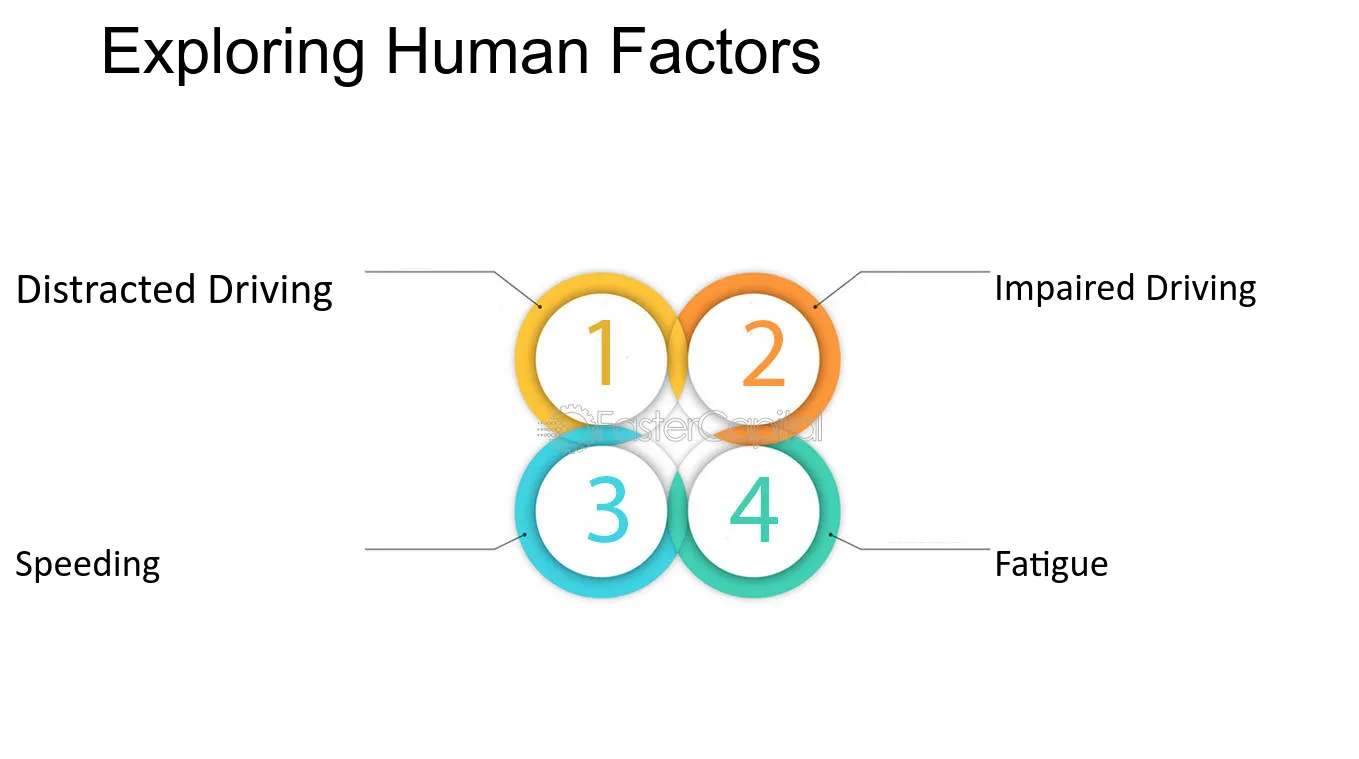
Exploring Human Factors - Understanding the Causes and Consequences of Motor Vehicle Accidents
15. Analyzing Human Factors in Industrial Accidents
Industrial accidents can happen in any work environment, and they usually occur due to human error or a combination of factors. Analyzing human factors in industrial accidents is crucial in understanding what went wrong and how to prevent similar incidents from occurring in the future. Human factors refer to the characteristics of humans that affect their performance and behavior. In industrial accidents, human factors can include factors such as fatigue, stress, lack of training, and insufficient supervision. Analyzing human factors requires a multidisciplinary approach, including input from experts in psychology, engineering, and safety.
To better understand the role of human factors in industrial accidents, here are some key insights:
1. Human factors are a major contributor to industrial accidents: Research has shown that human factors are a contributing factor in up to 80% of industrial accidents. This highlights the importance of analyzing human factors in accident reconstruction to identify the root cause of the accident.
2. Human factors are complex and interconnected: Human factors are not isolated factors that can be easily identified and fixed. They are complex and interconnected, and one factor can affect another. For example, fatigue can lead to reduced concentration and slower reaction times, which can increase the risk of accidents.
3. Training and supervision are critical in preventing human errors: Proper training and supervision are critical in preventing human errors in the workplace. Workers need to be trained on the proper use of equipment and safety procedures, and supervisors need to monitor their performance to ensure that they are following the correct procedures.
4. Human factors can be mitigated through system improvements: While human factors cannot be eliminated entirely, they can be mitigated through system improvements. For example, installing safety devices on equipment can reduce the risk of accidents due to human error.
5. Case study: The Deepwater Horizon oil spill: The Deepwater Horizon oil spill in 2010 was caused by a combination of factors, including human error. The crew on the rig failed to follow proper safety procedures, and there were also design flaws in the blowout preventer. Analyzing the human factors in this accident helped to identify the root cause and prevent similar incidents from occurring in the future.
Analyzing human factors in industrial accidents is crucial in preventing similar incidents from occurring in the future. By understanding the complex and interconnected nature of human factors, and implementing proper training, supervision, and system improvements, we can reduce the risk of accidents in the workplace.
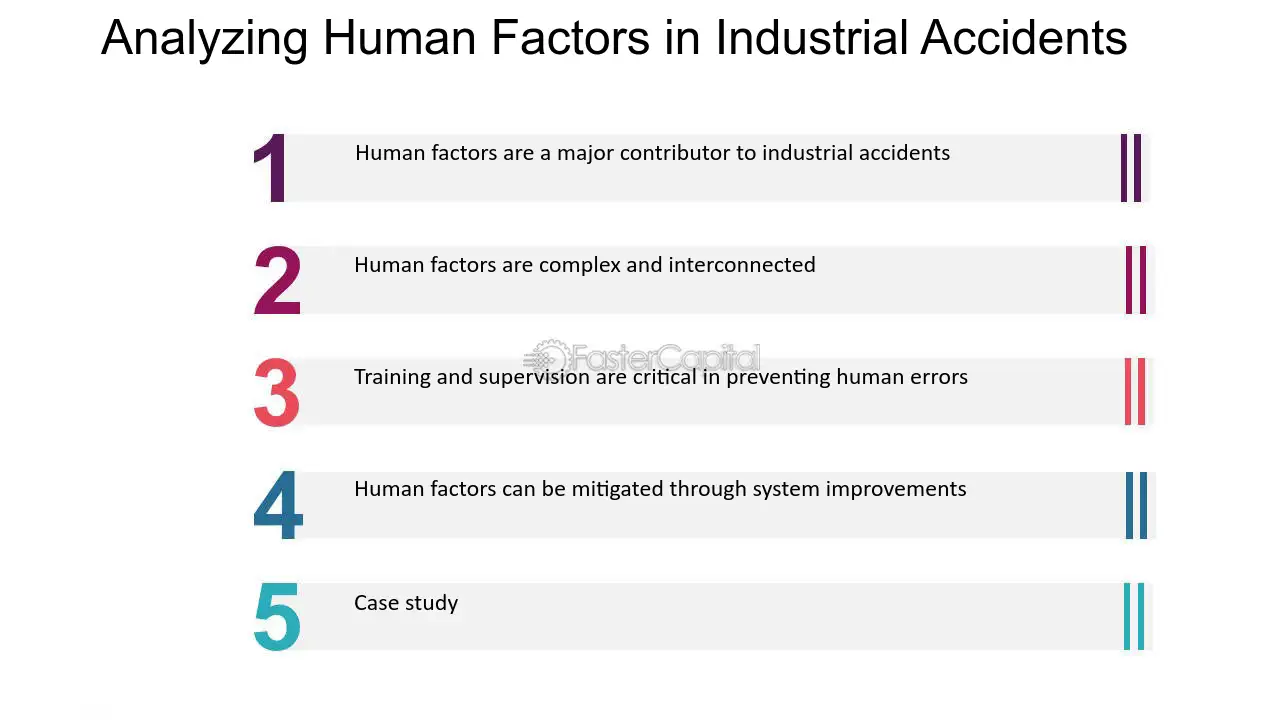
Analyzing Human Factors in Industrial Accidents - Unraveling the Mystery: The Science of Industrial Accident Reconstruction
16. Recognizing the Implications of Human Factors in Risk Evaluation
Human factors play a major role in risk evaluation. It is easy to overlook the implications of human behavior when evaluating risk, but understanding how people react to situations and how they interact with their environment is essential for identifying potential risks and developing effective strategies to manage them.
Human behavior can be unpredictable and can contribute to the possibility of a negative outcome. For example, when evaluating the risk of an industrial accident, it is important to consider how the workers in the facility might react to sudden changes in their environment. If they are not adequately trained or if they do not understand the potential consequences of their actions, they may act in a way that increases the risk of an accident. Additionally, workers may be exposed to hazardous materials or perform risky tasks without proper safety equipment or procedures in place, increasing the chances of an accident occurring.
Another factor to consider when evaluating risk is how people interact with technology. Technology can both help and hinder our ability to assess and respond to risk. On one hand, it may provide us with more data and information about potential risks, allowing us to make more informed decisions. On the other hand, it can introduce new risks, such as cyber security threats or data breaches. When assessing risk, it is important to consider how people interact with technology and how it affects the overall risk picture.
Professional business development services for your startup
FasterCapital provides various types of business development and becomes your long-term growth partner